Lately there has been some discussion about
Brooks saddles in the comments sections of the posts. We have
Brooks saddles on all six of our bicycles, and we have learned a lot about them. So I offer these notes for those riddled with indecision about which
Brooks to get.
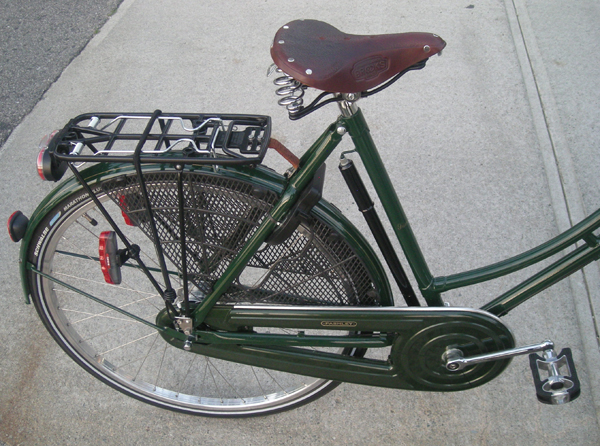
When choosing a
Brooks saddle, there are really only two main factors to consider: width and spring. I will try to explain the role of each.
WIDTHThe basic rule is: The more upright your riding position (handlebars above saddle level), the wider your saddle needs to be. Brooks saddles come in several width categories.
For upright riding: The B72, B66, B67, B68, and B73 are all pretty much the same, generous width and are all appropriate for a an upright bicycle. Which one of them you will prefer depends on your preference for sprung vs unsprung saddles, and whether your bicycle has a modern or an old-style seat post (for example, the B66 and B67 are identical, except the latter is designed to fit modern seat posts).

If you are heavier than 200lb and are riding a completely upright bicycle, you may want to consider the B33 or the B190. These are extra heavy-duty saddles and can take even the weightiest of riders on long upright trips.
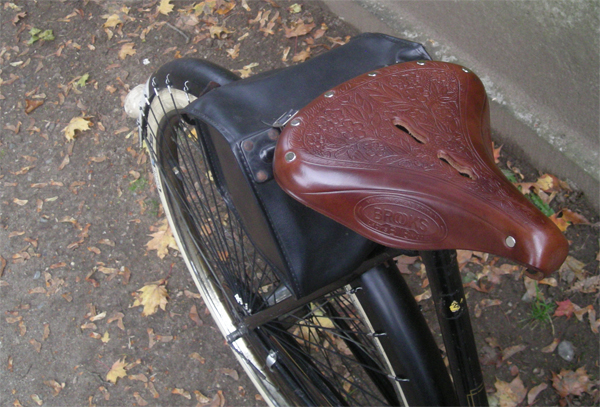
If you are female, love Edwardian design, and have a bicycle with very relaxed geometry, there is also the B18 "Lady". This is a very wide and short saddle, designed to be ridden by women wearing skirts and sitting completely upright on a bicycle with an extremely slack seat tube. See here for a detailed discussion of this saddle.
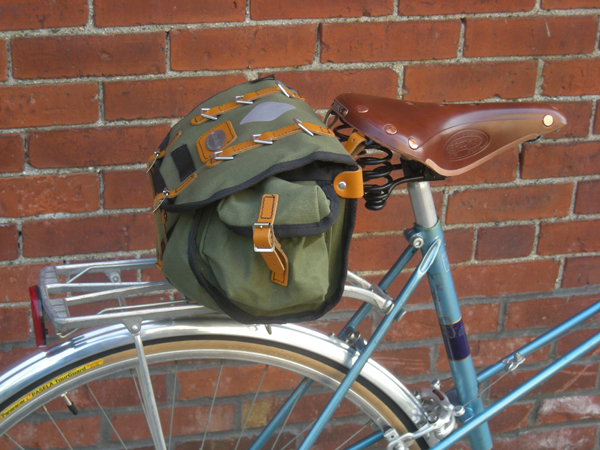 For leaned-forward riding:
For leaned-forward riding: If you are riding in a forward-leaning position so that your saddle is right at or above the level or your handlebars, in my opinion there are only two
Brooks saddles to choose from unless you are a very aggressive cyclist: the B17 and the Flyer. These are in fact the same saddle, only the Flyer has springs and the B17 does not.
In my view, all the other
Brooks roadbike saddles (the B17 Narrow, the Team Pro, the Swift, and the Swallow) are too narrow for the majority cyclists who are likely to be reading this post. Many do not want to hear that, because those racing saddles often have the coolest aesthetics and come in all sorts of crazy colours and special editions. But cycling forums are full of people who bought the narrow saddle and are not able to ride them - either due to discomfort, or because the saddle falls apart under the rider's weight. The cycling style of a serious road cyclist is so aggressive, that their butt really only floats on the surface of the saddle, rather than actually sits upon it. That is what these saddles were designed for. If this does not describe your cycling style, I urge you to get a B17 or a Flyer.
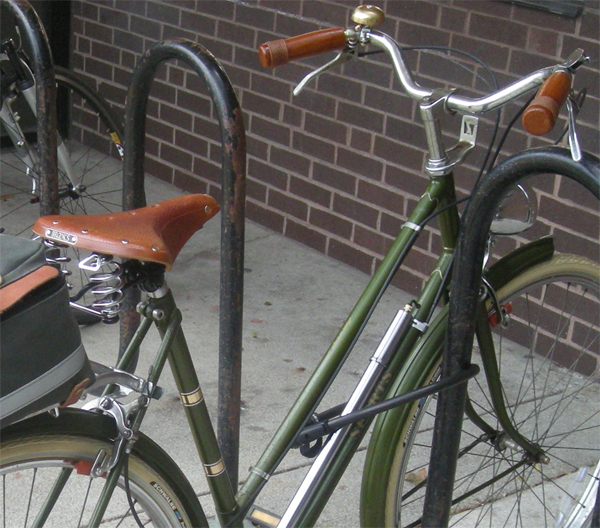 SPRINGS
SPRINGSSprung saddles provide suspension, the benefit of which is that you feel more comfortable going over bumps on the road. The drawback of suspension, is that you have less "control" over the ride. Which you prefer can be only decided via trial and error. For an upright bicycle, I would venture say that most cyclists tend to prefer the sprung saddles. For a more aggressive bike, it could go either way.
It is worth pointing out that not all sprung
Brooks saddles are sprung equally. The B72 has minimal springs. The Flyer has larger coils, but they are very tight and provide a feeling of shock absorbtion rather than full spring. So if you are considering putting a Flyer on a roadbike but are worried that it may be too bouncy, it may not necessarily be the case. The B66-67 is generously sprung. The B33 and B190 are monstrously sprung, so choose these carefully.
 "MEN'S" vs. "WOMEN'S" SADDLES?...
"MEN'S" vs. "WOMEN'S" SADDLES?...
You may notice that many saddles are offered in a "woman's" version, where the saddle number is followed by the letter "S" (B66 vs B66S). I think this system is often misunderstood. The "S" stands for "short", and these saddles are simply shorter than their non-"S" counterparts - making them
somewhat easier to mount and dismount while wearing a skirt without the skirt getting caught on the nose. I have ridden on both "S" and non-"S" saddles, and am still not sure whether the skirt-snagging difference is significant.
SPECIAL FINISHES
As for things like "Special," "Aged" and "Imperial" versions of the saddles, there is some debate whether they improve the saddle or not. The "Special" finish is more attractive and hardy than the regular finish, and features copper rivets. However, I and others have found saddles with the "Special" finish to be harder to break in. The "Aged" saddles are supposedly treated with some polymer, which some cyclists say improves their softness, while others say worsens it. And be careful choosing the "Imperial" versions of saddles, with cut-outs, because while some find those cut-outs helpful, others find them extremely painful. In short, my impression is that when in doubt it isa safer to go with standard finishes - unless you have a chance to try the saddle extensively.
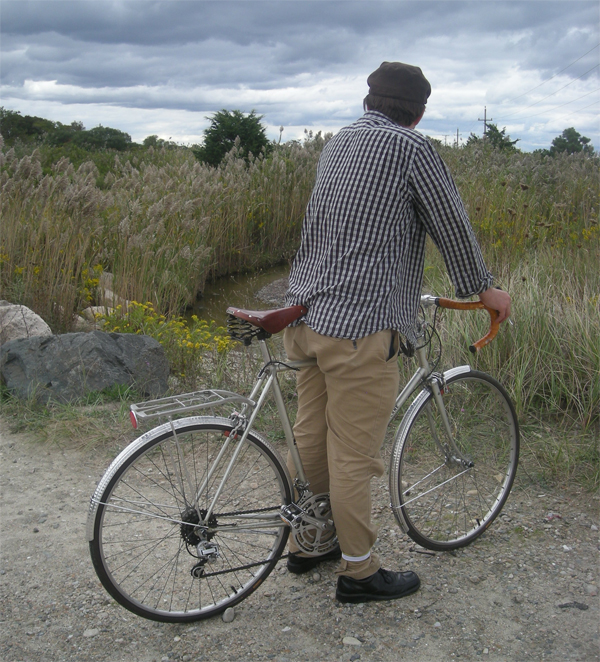 To summarise it all:
To summarise it all:If you need an upright saddle, choose one of these. If you will be cycling in a forward-leaning position, choose one of these. And unless you are an aggressive road cyclist, stay away from these. Sprung vs unsprung, and "S" vs non-"S", are personal choices within each category. Of course in the end everybody is different, but I believe this summary is applicable in the majority of cases.
 [image from Republic Bikes]
[image from Republic Bikes] [image from Republic Bikes]
[image from Republic Bikes] [image from Republic Bikes]
[image from Republic Bikes] [image from Republic Bikes]
[image from Republic Bikes]







 Taken at Picacho Peak State Park.
Taken at Picacho Peak State Park.

 When choosing a Brooks saddle, there are really only two main factors to consider: width and spring. I will try to explain the role of each.
When choosing a Brooks saddle, there are really only two main factors to consider: width and spring. I will try to explain the role of each. If you are heavier than 200lb and are riding a completely upright bicycle, you may want to consider the B33 or the B190. These are extra heavy-duty saddles and can take even the weightiest of riders on long upright trips.
If you are heavier than 200lb and are riding a completely upright bicycle, you may want to consider the B33 or the B190. These are extra heavy-duty saddles and can take even the weightiest of riders on long upright trips. If you are female, love Edwardian design, and have a bicycle with very relaxed geometry, there is also the B18 "Lady". This is a very wide and short saddle, designed to be ridden by women wearing skirts and sitting completely upright on a bicycle with an extremely slack seat tube. See here for a detailed discussion of this saddle.
If you are female, love Edwardian design, and have a bicycle with very relaxed geometry, there is also the B18 "Lady". This is a very wide and short saddle, designed to be ridden by women wearing skirts and sitting completely upright on a bicycle with an extremely slack seat tube. See here for a detailed discussion of this saddle.



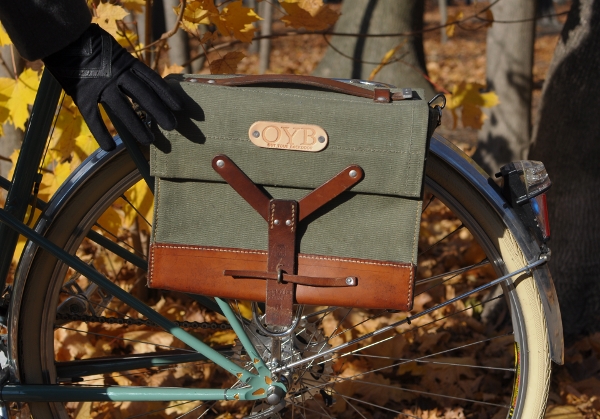 The OYB Pannier is a small Swiss army surplus bag, modified via the addition of rack attachments and other features byJeff Potter - the owner and author of the project Out Your Backdoor ("indie outdoor lore and more"). I purchased this bag asa smaller alternative to the enormous shopper pannier I normally use. My criteria were durability, classic aesthetics, a trustworthy attachment system, a reasonable price, and a size just large enough to snugly fit my medium format camera equipment or my (very small) laptop.While I am aware that these same bags (without the bike-ready modifications) can be purchased from several other sources, I opted for the OYB version because I wanted the modifications to be made by someone with experience and because I wanted to support the "Out Your Backdoor" project, which provides some great resources for its readers.
The OYB Pannier is a small Swiss army surplus bag, modified via the addition of rack attachments and other features byJeff Potter - the owner and author of the project Out Your Backdoor ("indie outdoor lore and more"). I purchased this bag asa smaller alternative to the enormous shopper pannier I normally use. My criteria were durability, classic aesthetics, a trustworthy attachment system, a reasonable price, and a size just large enough to snugly fit my medium format camera equipment or my (very small) laptop.While I am aware that these same bags (without the bike-ready modifications) can be purchased from several other sources, I opted for the OYB version because I wanted the modifications to be made by someone with experience and because I wanted to support the "Out Your Backdoor" project, which provides some great resources for its readers. Compact and boxy, the pannier is a Swiss military bag made of a thick, stiff, olive-green waxed canvas with brown leather trim and steel rivets. The OYB leather patch is a lighter shade than the rest of the leather on the bag, but this can easily be changed with a modest application of neatsfoot oil or even Proofide.I am not sure whether this particular bag started out as new-old-stock, or whether it had been used in its previous life, but to me it looks more like the former. The condition is better than I had expected based on the pictures and product description on OYB.
Compact and boxy, the pannier is a Swiss military bag made of a thick, stiff, olive-green waxed canvas with brown leather trim and steel rivets. The OYB leather patch is a lighter shade than the rest of the leather on the bag, but this can easily be changed with a modest application of neatsfoot oil or even Proofide.I am not sure whether this particular bag started out as new-old-stock, or whether it had been used in its previous life, but to me it looks more like the former. The condition is better than I had expected based on the pictures and product description on OYB.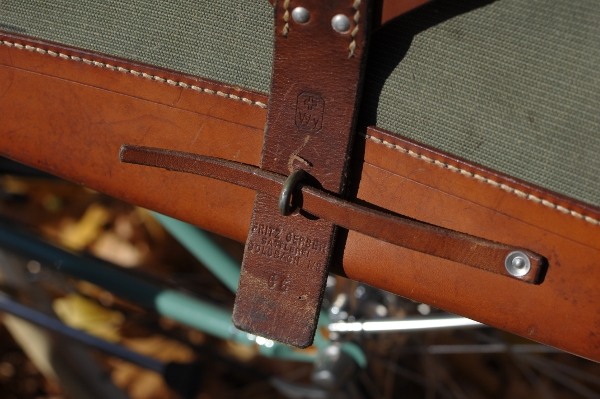 The closure system is simple and secure: That very stiff leather cord pulls out of the metal loop, and the thick leather strap lifts up off the loop to open the bag. For those curious, the imprint on the leather reads "Fritz Gerber Sattlerei, Goldbach."
The closure system is simple and secure: That very stiff leather cord pulls out of the metal loop, and the thick leather strap lifts up off the loop to open the bag. For those curious, the imprint on the leather reads "Fritz Gerber Sattlerei, Goldbach." The attachment system is a combination of metal hooks and bungee cords, with which the pannier is secured to the rear rack.The rack I have on this bicycle is theConstructeurrack fromVelo Orange, which is quite small.
The attachment system is a combination of metal hooks and bungee cords, with which the pannier is secured to the rear rack.The rack I have on this bicycle is theConstructeurrack fromVelo Orange, which is quite small.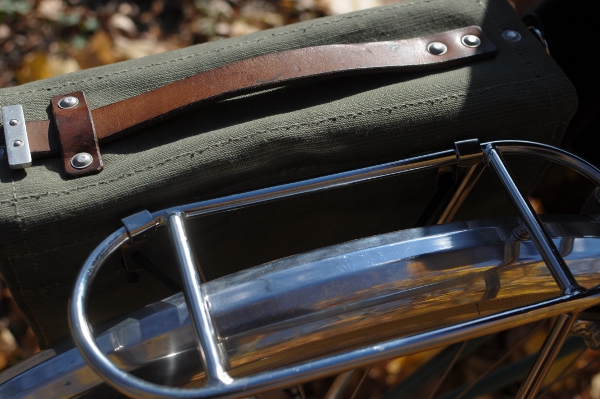 Here is a close-up of the metal hooks. They are riveted on to the bag.
Here is a close-up of the metal hooks. They are riveted on to the bag.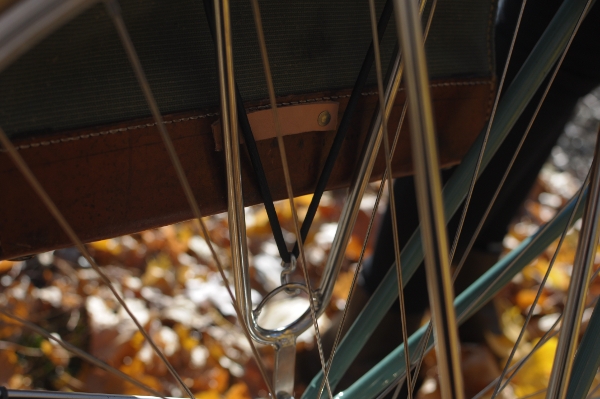 And here is a close-up of the bungee attachment. Together, these two attachment points ensure that the pannier does not sway or bounce against the rack - a good feature when you are planning to carry camera equipment. When the bag is not being used as a pannier, the bungee hook attaches to that small leather strip you see on the back of the bag - so that it does not hang loose. [Edited to add: I am now told that the bungee cord is supposed to go through that leather loop before you hook it to the bottom of the rack - oops.]
And here is a close-up of the bungee attachment. Together, these two attachment points ensure that the pannier does not sway or bounce against the rack - a good feature when you are planning to carry camera equipment. When the bag is not being used as a pannier, the bungee hook attaches to that small leather strip you see on the back of the bag - so that it does not hang loose. [Edited to add: I am now told that the bungee cord is supposed to go through that leather loop before you hook it to the bottom of the rack - oops.]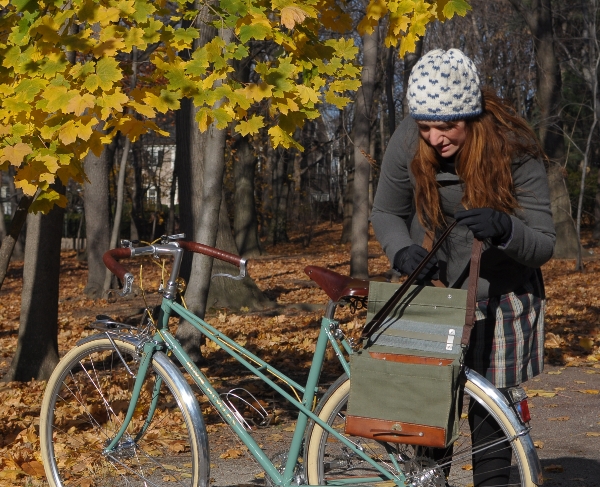 In addition to the rack attachments, the OYB pannier can be ordered with a number of other optional features, including shoulder strap attachments with a removable shoulder strap. I asked for the strap, because I pan to carry the bag around when off the bike, and this set-up essentially this gives me a camera bag and pannier in one. Other options include lights mounts, and a variety of other attachments.
In addition to the rack attachments, the OYB pannier can be ordered with a number of other optional features, including shoulder strap attachments with a removable shoulder strap. I asked for the strap, because I pan to carry the bag around when off the bike, and this set-up essentially this gives me a camera bag and pannier in one. Other options include lights mounts, and a variety of other attachments.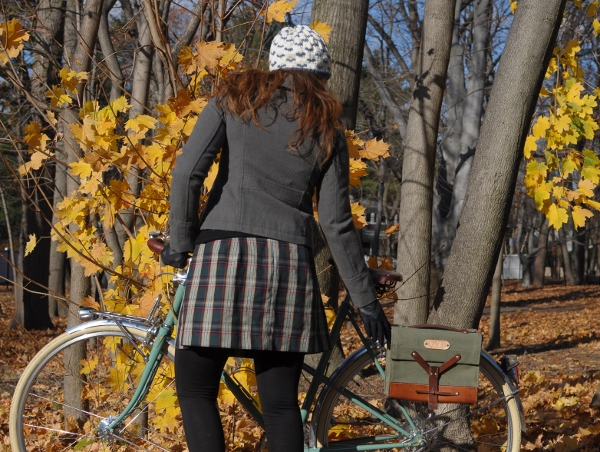 To give you a sense of scale, here is the pannier in relation to me and to the entire bike. It is a small bag. Dimensions are listed as:8.5" tall, 4" deep, 11.25" wide (5.4 liters). Inside, the length of the bag is listed at 10.75", but I was hoping against hope that it would fit my laptop. OYB gives instructions for stretching the bag out with magazines in order to make it fititems of that size, and I will give this a try.If I can get my laptop to fit, I will be thrilled - but I am not getting my hopes upand am prepared to content myself with this being a camera bag only.
To give you a sense of scale, here is the pannier in relation to me and to the entire bike. It is a small bag. Dimensions are listed as:8.5" tall, 4" deep, 11.25" wide (5.4 liters). Inside, the length of the bag is listed at 10.75", but I was hoping against hope that it would fit my laptop. OYB gives instructions for stretching the bag out with magazines in order to make it fititems of that size, and I will give this a try.If I can get my laptop to fit, I will be thrilled - but I am not getting my hopes upand am prepared to content myself with this being a camera bag only. If it were not for the laptop fit issue, this would pretty much be my dream pannier. The mil-spec colour scheme is not for everyone, but I love it, and it suits almost all of my bikes nicely. The durability of military surplus items is superb, and I appreciated getting the bag customised by Jeff atOYB. This is a classic, versatile, and reliable little pannier refashioned by someone who loves bicycles.
If it were not for the laptop fit issue, this would pretty much be my dream pannier. The mil-spec colour scheme is not for everyone, but I love it, and it suits almost all of my bikes nicely. The durability of military surplus items is superb, and I appreciated getting the bag customised by Jeff atOYB. This is a classic, versatile, and reliable little pannier refashioned by someone who loves bicycles.

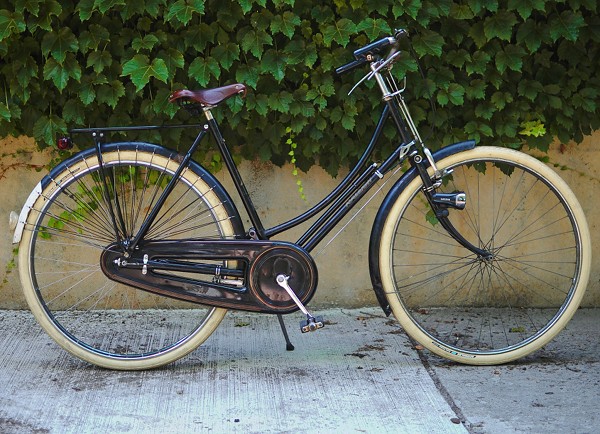


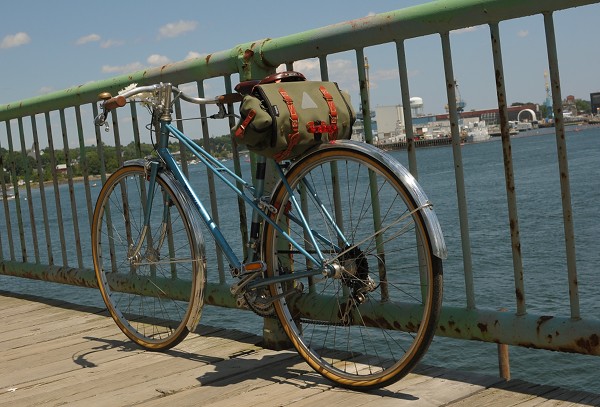

 The final hard move on Echo Wall, Ben Nevis. This is a video still shot by Claire.
The final hard move on Echo Wall, Ben Nevis. This is a video still shot by Claire. Racking up for the lead, looking pale. Video still: Claire MacLeod
Racking up for the lead, looking pale. Video still: Claire MacLeod At the shakeout before the most serious part of the climb. Video Still: Claire MacLeod
At the shakeout before the most serious part of the climb. Video Still: Claire MacLeod Echo Wall, I am just pulling over the roof, low on the arête. Video still: Claire MacLeod
Echo Wall, I am just pulling over the roof, low on the arête. Video still: Claire MacLeod Claire a tiny dot in Observatory Gully, left of the snow.
Claire a tiny dot in Observatory Gully, left of the snow. Claire looking remarkably happy to be on the Ben after midnight!
Claire looking remarkably happy to be on the Ben after midnight! Looking west from Ben Nevis at the end of a long and perfect day's climbing.
Looking west from Ben Nevis at the end of a long and perfect day's climbing.





 Gary comes out of the Chute! I only did this one once.
Gary comes out of the Chute! I only did this one once.







